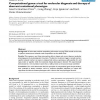11 search results - page 2 / 3 » A New Self-Reproducing Cellular Automaton Capable of Constru... |
ICS
2010
Tsinghua U.
14 years 2 months ago
2010
Tsinghua U.
Computation in the physical world is restricted by the following spatial locality constraint: In a single unit of time, information can only travel a bounded distance in space. A ...
DNA
2005
Springer
13 years 10 months ago
2005
Springer
Recent experimental progress in DNA lattice construction, DNA robotics, and DNA computing provides the basis for designing DNA cellular computing devices, i.e. autonomous nano-mech...
JAC
2008
13 years 6 months ago
2008
Cellular automata are a simple model of parallel computation. Many people wonder about the computing power of such a model. Following an idea of S. Wolfram [16], M. Cook [3] has pr...
BMCBI
2007
13 years 5 months ago
2007
Background: A finite state machine manipulating information-carrying DNA strands can be used to perform autonomous molecular-scale computations at the cellular level. Results: We ...
RECOMB
2005
Springer
14 years 5 months ago
2005
Springer
Background: Most cellular processes are carried out by multi-protein complexes, groups of proteins that bind together to perform a specific task. Some proteins form stable complex...

